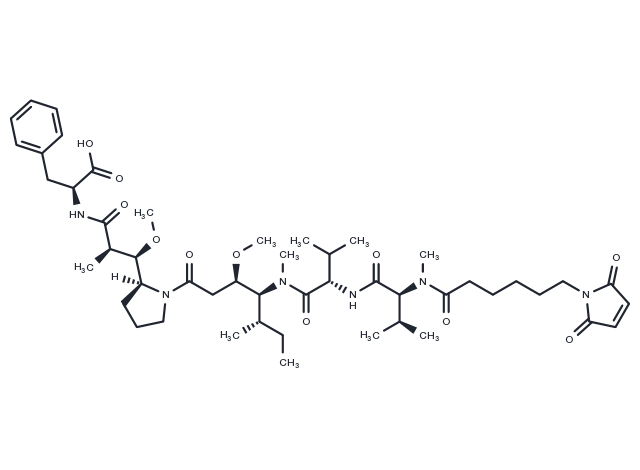Powder: -20°C for 3 years | In solvent: -80°C for 1 year


McMMAF is a protective group-conjugated MMAF. MMAF is a potent tubulin polymerization inhibitor.It is a MMAF derivative having a Maleimidocaproyl linker (MC linker), which is ready to conjugate to antibody or other proteins or biopolymers. Mafodotin is a useful agent for make antibody drug conjugate (ADC) for targeted drug delivery.

| Pack Size | Availability | Price/USD | Quantity |
|---|---|---|---|
| 1 mg | In stock | $ 51.00 | |
| 5 mg | In stock | $ 122.00 | |
| 10 mg | In stock | $ 197.00 | |
| 25 mg | In stock | $ 455.00 | |
| 50 mg | In stock | $ 672.00 | |
| 100 mg | In stock | $ 956.00 |



| Description | McMMAF is a protective group-conjugated MMAF. MMAF is a potent tubulin polymerization inhibitor.It is a MMAF derivative having a Maleimidocaproyl linker (MC linker), which is ready to conjugate to antibody or other proteins or biopolymers. Mafodotin is a useful agent for make antibody drug conjugate (ADC) for targeted drug delivery. |
| In vitro | MMAF induces potent antitumor effects when conjugated via protease cleavable linkers to a monoclonal antibody targeting internalizing, tumor-specific cell surface antigens. MMAF is a new auristatin derivative with a charged C-terminal phenylalanine that attenuates its cytotoxic activity compared to its uncharged counterpart, Monomethyl auristatin E (MMAE). It cannot be used as a drug itself because MMAF is highly toxic. The linker to the monoclonal antibody is stable in extracellular fluid but is cleaved by cathepsin once the conjugate has entered a tumor cell, thus activating the anti-mitotic mechanism. |
| Synonyms | Maleimidocaproyl monomethylauristatin F |
| Molecular Weight | 925.16 |
| Formula | C49H76N6O11 |
| CAS No. | 863971-19-1 |
Powder: -20°C for 3 years | In solvent: -80°C for 1 year
DMSO: 100 mg/mL (108.09 mM)
You can also refer to dose conversion for different animals. More
bottom
Please see Inhibitor Handling Instructions for more frequently ask questions. Topics include: how to prepare stock solutions, how to store products, and cautions on cell-based assays & animal experiments, etc.
McMMAF 863971-19-1 Cytoskeletal Signaling Microtubule Associated inhibit Maleimidocaproyl monomethylauristatin F Inhibitor Drug-Linker Conjugates for ADC inhibitor
